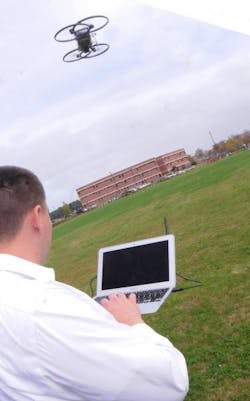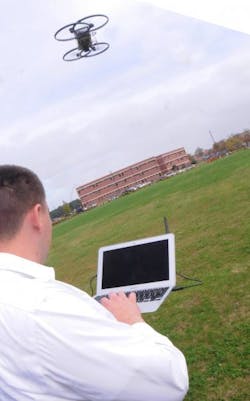Battlefield logisticians like drone technology. A lot.
A lot of folks think the freight-hauling potential of aerial drones, not to mention driverless trucks – which are sort of “ground-based drones” when you think about them a bit – is limited at least for the present time; too many concerns about the safety risks when interacting with human-operated vehicles and all that.
Just don’t tell the U.S. military that.
Battlefield logisticians, especially, see real promise in both aerial drones and driverless trucks in terms of combat operation; resupplying forward operating bases, for example, while minimizing the need to put soldiers on convoy-protection duty.
The U.S. Army’s Combined Arms Support Command (CASCOM) at Ft. Lee, Virginia, recently put together an interesting story on this very subject, with its resident expert noting that the use of unmanned vehicles – aerial or otherwise – isn’t a new subject in military logistics circles.
“The Marine Corps used an unmanned aircraft – a helicopter called KMAX – for two years to supply forward units,” Larry Perecko, branch chief of science and technology at CASCOM’s Sustainment Battle Lab, explained.
“It delivered over a million short tons of supplies using two unmanned aircraft,” he said, with both the U.S. Marine Corps and U.S. Navy continuing to develop unmanned cargo-carrying aerial machines based on that successful trial.
This is a relatively new mission for aerial drones, Perecko noted, as they originally began seeing military service back in Vietnam first as reconnaissance tools and later in the aftermath of September 11 as “weapons of destruction.”
Yet “sustainment missions” are increasingly becoming a main focus of military drone research.
Take the U.S. Army Tank Automotive Research, Development and Engineering Center (TARDEC), based in Warren, Michigan, which continues to work on driverless truck systems.
CASCOM is helping support TARDEC’s use of drone technology for ground vehicles, which is an effort focused on raising efficiency while reducing the risk to soldiers charged with transporting materiel in the battlespace, Perecko emphasized.
“We wanted to reduce demand by satisfying more of that demand at the point of need,” he said. “In the instance where we have to deliver things, we want to reduce risks to soldiers by automating some of those dull, dangerous and dirty tasks they currently perform like driving for eight hours on a main supply route littered with IEDs [improvised explosive devices].”
For aircraft drones, the focus areas are essentially the same, but Perecko explained there is the potential for more savings in resources because manned aircraft require far more extensive protection measures.“Every time you use manned aircraft for sustainment, you’re taking assets away from other operational missions,” he pointed out.
[At right, Robert Baltrusch, industrial design team lead at Survice Engineering, remotely operates a one-third-scale electric drone called a “hoverbike” for a demonstration late last year at CASCOM. The aircraft is being developed for the Department of Defense under the Soldier Aerial Mobility Vehicle (SAMV) project, which aims to develop an aircraft capable of manned or unmanned operation, carrying up to an 800-pound payload and flying within a 125-mile range.]
Ideally, transportation elements of the future will be multi-modal, Perecko noted, capable of remotely moving materiel in more ways than one.
For example, in the future, a truck company could not only transport supplies and equipment via driverless ground vehicles but also use drone aircraft assets as well.
That capability “gives a commander flexibility in what [mode] he decides to use to deliver supplies based on the threat, the location of supported units and weather conditions,” Perecko stressed.
He added, too, that remotely operated air assets in particular create “multiple dilemmas” for the enemy – providing friendly forces with some measure of unpredictability during re-supply and other missions.
“As it stands now, the enemy pretty much knows where we are and what roads we have to use to get to where we’re trying to go,” Perecko explained. “It’s easy for them to stage themselves along those routes to either attack us or place IEDs. But … with unmanned aerial assets, it won’t be as easy for them because they won’t know which routes we will take or what altitude we’ll fly, etc.”
Yet this doesn’t mean soldiers are completely eliminated from the picture.
“When we say we want to automate soldier’s tasks, it doesn’t mean we don’t need them,” Perecko emphasized; rather, it frees them up to perform other more critical tasks.
“For example, soldiers will still need to maintain vehicles and program them to operate,” he noted. “They also will have to monitor vehicles in the execution of missions, plus load and unload them.”
But how close is the military to making such “self-piloting” drones – both aerial and ground-based – a true reality, outside of the research project sphere?
Well Perecko pointed out he’s witnessed a pilotless Blackhawk helicopter demonstration in Florida and thinks similar systems for aircraft could be fielded soon.
“I think we’re going to see a lot of this technology in the next five years because the utility has been proven and there are ongoing efforts,” he added.
Progress in the tactical vehicle arena seems to be further along, Perecko emphasized, as a semi-autonomous ground vehicle system is awaiting approval and could be fielded within the next five years.
Meanwhile, a fully automated convoy system could be operational within the next 10 years, though a lengthy approval process, regulatory concerns and of course funding are potential obstacles that could delay development and fielding for any system, he stressed.
Still, Perecko believes “drone technology will likely prevail and emerge to play an important role in the future of sustainment operations” where the U.S. military is concerned.
But if such technology is proven to keep soldiers out of harm’s way, saving life and limb in the process, I think we may see an even faster development timeline occur.

